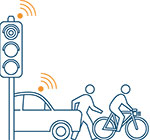CAVI components
The CAVI project includes 4 components:
- Cooperative Intelligent Transport Systems (C-ITS) pilot
- Cooperative and Highly Automated Driving (CHAD) pilot
- Vulnerable road user pilot
- Change Management
Cooperative Intelligent Transport Systems (C-ITS) Pilot 

The largest component of CAVI is the Cooperative Intelligent Transport Systems (C-ITS) Pilot. The pilot will take place on public roads in and around the City of Ipswich.
The pilot will be delivered in 2 phases – planning and pilot deployment –a decision made between each phase will confirm the investment logic and the pilot approach.
Testing will start with the C-ITS safety use-case, including vehicle-to-infrastructure (V2I) and vehicle-to-vehicle (V2V) applications. There will be around 500 public and fleet vehicles retro fitted with C-ITS technologies, and roadside C-ITS devices installed on arterial and motorways. These devices allow vehicles and infrastructure to talk to each other to share real-time information about the road and to generate safety-related warnings messages for drivers.
Use-case applications
Emergency braking warning (V2V)
This warning alerts drivers to a cooperative vehicle braking hard some distance ahead.
This warning alerts drivers to a cooperative vehicle braking hard some distance ahead.
Three cars are travelling along a road. The first car brakes suddenly, and the in-vehicle cooperative intelligent transport system, or C-ITS, sends out a warning message advising of a sudden braking action.
The car at the back of the queue receives this warning message via its in-vehicle C-ITS system, and brakes smoothly. The middle car, has to brake suddenly to avoid a crash.
In car view
Three cars are travelling along a road. We see the view of the driver at the back of the queue. The first car brakes suddenly, and the brake lights flash.
The car at the back of the queue of 3 cars receives a warning message of sudden braking up ahead on an in-vehicle display tablet. The car brakes smoothly and the speedometer slows to zero. The car comes to a smooth stop.
The middle car has to brake suddenly to avoid a crash.
To find out more visit www.qld.gov.au/cavi
In-vehicle speed warning (V2I)
This warning provides drivers with information about active, static or variable speed limits. It then alerts them if they are exceeding that limit.
This warning provides drivers with information about active, static or variable speed limits. It then alerts them if they are exceeding that limit.
In car view
A car is travelling along a road at 75km an hour as seen on the driver’s speedometer. The car passes a 60km an hour speed sign, and receives a slow down warning on an in-vehicle display tablet. The car slows then slows to 59km.
The car passes a school zone sign and receives a 40km ahead warning on the in-vehicle display tablet. The car slows to 40km an hour and the warning symbol changes to a smiley face on the display tablet.
Aerial view
A car is travelling along a road, behind a bus. The car receives an advisory message of the change in speed limit via a cloud based traffic management system. The car’s brake lights flash, and the car slows down.
The car receives a secondary advice message from the cloud as it enters a school zone and the speed limit changes to 40km an hour as shown on the school zone sign. The car continues through the school zone at the reduced speed.
Turning warning for bicycle riders and pedestrians (V2V)
This warning alerts drivers to pedestrians or bicycles crossing at an upcoming intersection.
This warning alerts drivers to pedestrians or bicycles crossing at an upcoming intersection.
A number of vehicles are interacting at an intersection as a yellow car approaches indicating to turn right.
A large truck approaching from the opposite direction blocks the crossing pedestrians from the view of the yellow car driver.
The traffic lights, where 2 pedestrians are crossing, is communicating with an approaching car.
This message is sent out from a cooperative intelligent transport system, or C-ITS, unit connected to the traffic lights.
This car receives a message that the pedestrian crossing is in use, and to watch out for pedestrians.
The car waits for the pedestrians to cross the road and turns right safely.
In-car view
A car approaching an intersection with green traffic lights, indicates to turn right.
Oncoming cars and trucks to the right hand side of the driver’s windscreen, block the view of the driver of pedestrians already crossing the road.
The car receives an advisory warning on the in-vehicle display tablet indicating pedestrians and cyclists ahead, at the right-turn intersection.
Once the pedestrian and cyclist are clear of the intersection, the car turns right safely.
To find out more visit www.qld.gov.au/cavi
Road works warning (V2I)
This warning alerts drivers to upcoming roadworks, giving them time to slow down or change lanes.
This warning alerts drivers to upcoming roadworks, giving them time to slow down or change lanes.
A red car is travelling along a 2-lane road, and receives an advisory message of upcoming roadworks via a cloud based traffic management system.
The car’s brake lights flash, and the car slows down as it goes past a road work ahead, slow down, 60km signs.
The car then approaches a lane closed, 40km sign indicates right, and moves to the right hand lane.
The car then approaches a 40km, roadworks sign, and slows downs as it passes roadworkers, separated from traffic by traffic cones.
In-car view
A car travelling along a 2-lane road passes a road work ahead, reduce speed, 60 km roadwork sign on the left hand side of the road.
The car receives an advisory warning on the in-vehicle display tablet indicating roadworks ahead and reduces speed.
The car approaches a lane closed, reduce speed, 40km sign and receives a second advisory warning
indicating the left hand lane is closed, and to reduce speed to 40km an hour and roadworkers are on site.
To find out more visit www.qld.gov.au/cavi
Back-of-queue-warning (V2I)
This warning provides drivers with information about an upcoming traffic queue.
This warning provides drivers with information about an upcoming traffic queue.
Aerial view
A car is travelling along a 2-lane road, and receives an advisory message of upcoming roadworks via a cloud based traffic management system. The car’s brake lights flash, and the car slows down as it approaches a queue of stopped cars ahead.
In-car view
A car is travelling along a road at 98km, as shown on the car’s speedometer. The car receives an advisory warning on the in-vehicle display tablet indicating congestion ahead. The car reduces speed to 10km as shown on the car’s speedometer.
To find out more visit www.qld.gov.au/cavi
Red light violator warning (V2I/V2V)
This warning alerts drivers that another cooperative vehicle is likely to run a red light across their path at the intersection ahead.
This warning alerts drivers that another cooperative vehicle is likely to run a red light across their path at the intersection ahead.
Two cars are approaching an intersection – a white car approaching a green light, and a green car approaching a red light.
The white car receives a warning message from the traffic lights that another cooperative vehicle is likely to run the red light across their path. The white car then brakes suddenly to avoid a crash with the green car that runs the red light.
The white car then continues on its way with the green light.
In-car view
A car is travelling along a road, with a green traffic light visible ahead.
The driver receives a warning message via an in-vehicle display tablet that another cooperative vehicle is running a red light at this intersection and crash into them.
The green car runs the red light and the white car brakes suddenly and slows to a stop.
Once the intersection is clear of traffic, the car continues on its way with the green light.
To find out more visit www.qld.gov.au/cavi
Red light warning (V2I)
This warning alerts drivers if it’s likely that they’ll drive through a red light ahead, unless they brake.
This warning alerts drivers if it’s likely that they’ll drive through a red light ahead, unless they brake.
Aerial view
Two cars and a truck are approaching an intersection – a white car is approaching the intersection with a red light, and a red car and truck approaching the intersection with a green light.
The white car receives a warning message that they are approaching a red light, and are likely to drive through the red light unless they brake.
The white car brakes, and comes to a complete stop as the red car and truck cross the intersection.
In-car view
A car is travelling along a road, with a red traffic light visible ahead.
The driver receives a warning message via an in-vehicle display tablet that it is likely to run a red light unless it brakes.
The car brakes suddenly, and slows to a stop as seen by the reduction in speed on the car speedometer.
A red car passes in front of the driver from the right hand side and crosses in front of the car heading left.
To find out more visit www.qld.gov.au/cavi
Stopped or slow vehicle warnings (V2V)
This warning alerts drivers of an impending rear-end collision with another cooperative vehicle ahead of them.
Aerial view
A blue car is travelling along a road, with noticeable smoke coming from the rear of the car. A yellow car approaches from behind, and we see a message ping between the 2 cars, depicted by a white dotted line. The yellow car noticeably slows down to avoid crashing into the back of the blue car.
In-car view
A car is travelling along a road, with the view from the drivers perspective, through the front windscreen. The car receives an advisory message of a slow vehicle up ahead on an in-vehicle display tablet. The driver brakes smoothly and slows down to safely approach a car with smoke coming from the rear.
To find out more visit www.qld.gov.au/cavi
Hazard warning (V2I)
This warning alerts drivers to upcoming hazards, such as water on the road, road closures, or a crash.
This warning alerts drivers to upcoming hazards, such as water on the road, road closures, or a crash.
Aerial View
Two cars in each lane are travelling along a 2-lane road. The red car receives an advisory message of a hazard ahead via a cloud based traffic management system. The red car’s brake lights flash and slows down to safely pass a stationary tow truck with a broken down car on it. The green car brakes suddenly to avoid crashing into the rear of the tow truck.
In-car view
Two cars in each lane are travelling along a 2-lane road. We see the view of the red car at the rear.
The car receives an advisory message of a hazard up ahead on an in-vehicle display tablet. The car brakes smoothly and slows to safely pass a stationary tow truck with a broken down car on the back.
The green car in the left lane brakes suddenly to avoid crashing into the rear of the tow truck.
To find out more visit www.qld.gov.au/cavi
Cooperative and Highly Automated Driving (CHAD) pilot 

A small number of cooperative and automated vehicles will be tested on public and private roads using trained and public participants. The pilot will assess:
- asset readiness (that is, can existing signs and lines be read by automated vehicles)
- driver behaviour (human machine interface)
- vehicle performance
Vulnerable road user pilot

This pilot will seek to develop and undertake proof-of-concept tests for new technology applications that address specific vulnerable road user priorities including bicycle, pedestrian and motorcycle safety issues.
Change Management

A change management process for the Department of Transport and Main Roads to consider the capabilities and resources required to support widespread deployment of these vehicles on our roads.